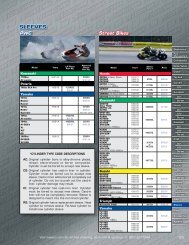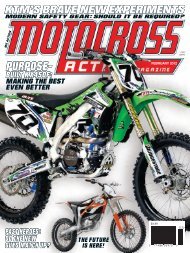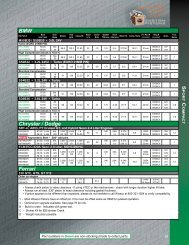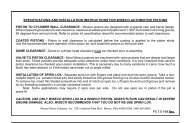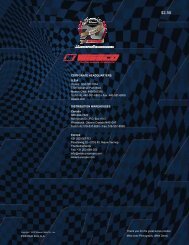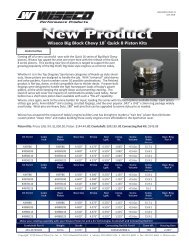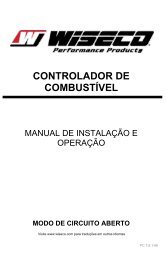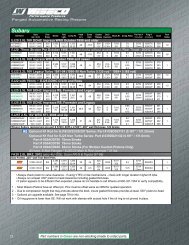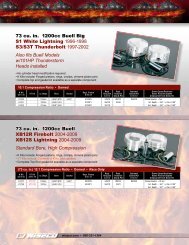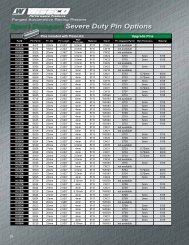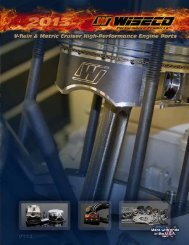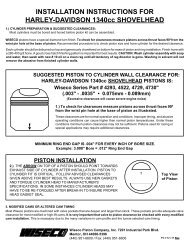Complete Catalog - Wiseco
Complete Catalog - Wiseco
Complete Catalog - Wiseco
You also want an ePaper? Increase the reach of your titles
YUMPU automatically turns print PDFs into web optimized ePapers that Google loves.
“ WhY DO I NEED TO CALIbRATE ThE O2 SENSOR WITh<br />
INNOvATE PRODUCTS?” ThE ANSWER IS SIMPLE… ACCURACY!<br />
Innovate Motorsports is the only wideband O2 device manufacturer on the market that allows the user to field calibrate the O2 sensor.<br />
Our patented sensor calibration allows compensation for the two main causes of inaccurate air/fuel ratio data; sensor wear and altitude.<br />
The alternative to calibrating your sensor in the field is to rely on the sensor’s Bosch factory calibration. The Bosch factory sensor<br />
calibration is done using a fixed atmospheric pressure value that may be incorrect for your location from the start!<br />
SENSOR WEAR<br />
Most popular wideband systems, including Innovate, utilize the Bosch LSU 4.2 wideband O2 sensor. This sensor has an integrated<br />
calibration resistor located in the connector on the plug end. Like all sensors in a vehicle, O2 sensors wear over time and being<br />
able to recalibrate the sensor is the only way to ensure continued accuracy. Innovate Motorsports is the ONLY wideband controller<br />
manufacturer that makes it possible for the sensor to be recalibrated because we do not rely on or utilize the Bosch calibration resistor.<br />
Without the ability to calibrate, your wideband will continue to rely on the Bosch factory pre-calibrated resistor settings as your sensor<br />
wears. The results of doing so have been published by Bosch in a technical document referenced below:<br />
LSU test bench at constant 20 degC gas temp and constant 14.7 PSI ambient.<br />
New After 500hr test bench run After 2000hr test bench run<br />
Calibrated measurement gas for 24.99 AFR 24.99 ± .73 AFR 24.99 ± 1.47 AFR 24.99 ± 2.20 AFR<br />
Calibrated measurement gas for 11.76 AFR 11.76 ± .15 AFR 11.76 ± .29 AFR 11.76 ± .59 AFR<br />
According to the Bosch spec the sensor leaves the factory with a ± margin of error of .15 AFR. In IDeAL lab conditions sensor wear will cause<br />
the sensor to drift to an accuracy of ± .29 AFR after approximately 500 hours and ± .59 AFR after approximately 2000 hours. In aftermarket<br />
performance applications where engines typically see richer conditions with higher exhaust gas temperatures, the sensor will degrade at<br />
a greatly accelerated rate compared to the Bosch spec. Other factors such as detergents, additives in the fuel, sensor placement and lead<br />
will also accelerate sensor wear even further. The Innovate Motorsports patented digital wideband sensor controller technology eliminates<br />
any and all inaccuracies caused by sensor wear. The simple and quick free air calibration process will ensure that you have measurements<br />
accurate to ± .1 AFR for the life of the sensor.<br />
ALTITUDE COMPENSATION<br />
Changes in altitude will also affect the accuracy of the<br />
measurements. It is important to note the Bosch spec<br />
tests the accuracy of the sensor at 14.7 PSI atmospheric<br />
pressure (sea level). In the same way that the precalibrated<br />
resistor can not compensate for sensor<br />
wear, it can not compensate for changes in altitude.<br />
To illustrate how important a difference in altitude<br />
we can look at the difference between Innovate<br />
Motorsports’ office in Huntington Beach, CA which is<br />
at sea level, and Willow Springs Raceway in Rosamond,<br />
Source: Bosch Y 258 K01 005-000e technical document.<br />
Innovate Motorsports’ recommended calibration schedule:<br />
Normally aspirated<br />
daily driver<br />
Turbo car, daily<br />
driver (tuned rich)<br />
Race car (running<br />
leaded race fuel)<br />
Dyno use<br />
Calibrate before installation of the new sensor. Calibrate the<br />
sensor again after 3 months of use. Thereafter calibrate once<br />
a year or every 20,000 miles, whichever comes first.<br />
Calibrate before installation of the new sensor. Calibrate the<br />
sensor again after 3 months of use. Thereafter calibrate twice<br />
a year or every 10,000 miles, whichever comes first.<br />
Calibrate before the new sensor. Calibrate once per race<br />
weekend.<br />
Calibrate the new sensor. Calibrate every 2-3 days, or more<br />
frequently, depending on usage.<br />
CA. The difference in altitude is approximately 2400 ft. between the two locations; this will make a difference in your measurements<br />
by as much as .2 AFR. If you do not have the ability to calibrate your sensor, and you happen to live in Denver (5280 ft. above sea level),<br />
your readings will be incorrect right from the start and will progressively get worse as the sensor degrades.<br />
CONCLUSION<br />
The purpose of installing a wideband O2 system in a high performance engine is to accurately monitor the engine’s operating air/fuel<br />
ratio to ensure maximum performance and safety. If you are using a wideband system that does not allow the sensor to be recalibrated,<br />
you are putting your engine at risk. Whether you only perform the simple calibration once when you first install a sensor, or at the<br />
recommended intervals; Innovate Motorsports’ patented digital wideband O2 sensor controller technology will ensure that you have<br />
the fastest and most accurate wideband instrument available at any price.<br />
The difference between a wideband that does not require calibration and an Innovate Motorsports wideband is ACCURACY.<br />
440-951-6600 www.wiseco.com<br />
61



